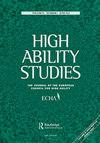教师、家长、同伴的天赋评估与多元智能自我评估的一致性
IF 1.8
4区 教育学
Q2 EDUCATION, SPECIAL
引用次数: 5
摘要
摘要评估天赋是识别天才学童的一个不可避免的过程,涉及到与学童直接接触的所有参与者。由于评估被视为评估者的主观意见,我们的目的是确定我们在评估天赋识别时可以考虑的确定性水平。与此相关,这项研究基于教师、家长、同龄人和学童自我评估对学童天赋评估合规性的验证。这项研究是对波斯尼亚和黑塞哥维那115名8岁和9岁的学童进行的。天赋评估工具是以多元智能理论为基础的。这些仪器通过了几次验证,并确定了它们的度量特征。内容有效性已经建立,它以高质量的方式表明,测量仪器提供了对多元智能进行适当测量的可能性,而仪器的可靠性则由Cronbach的α系数来证实。Pearson的相关分析证实了教师、学童、同龄人的认知与自我评估之间的正相关性。Kruskal–Wallis测试和Dunn的事后测试表明,所有四组评估员的评估结果高度一致。评估中最一致的是音乐智力,而评估中最大的差异是父母与其他评估者的结合。这项研究的发现将用于创建一个天赋评估软件。本文章由计算机程序翻译,如有差异,请以英文原文为准。
Concordance between giftedness assessments by teachers, parents, peers and the self-assessment using multiple intelligences
ABSTRACT Assessing giftedness is one of the inevitable processes in the identification of gifted schoolchildren which involves all the actors included in the direct contact with schoolchildren. Since the assessments are regarded as a subjective opinion of the assessor, our aim is to determine the level of certainty that we can take into account when assessing giftedness identification. In relation to that, the research is based on the validation of compliance in the giftedness assessments of schoolchildren by: teachers, parents, peers and schoolchildren’s self-assessment.The research was conducted on 115 schoolchildren aged 8 and 9 in Bosnia and Herzegovina. The instruments for giftedness assessment were based on the theory of multiple intelligences. The instruments passed several validations, and their metric characteristics were determined. The content validity has been established, and it shows in a high-quality manner that the measuring instrument provides the possibility of appropriate measurement of multiple intelligences, while the reliability of the instrument is confirmed by Cronbach’s alpha coefficient. The positive correlation among the perceptions of teachers, schoolchildren, peers, and the self-assessment is confirmed by Pearson’s correlation analysis. The Kruskal–Wallis test, with the Dunn’s post-hoc test, indicates that there is a high congruence between the assessments of all four groups of assessors. The greatest agreement in assessments was found in musical intelligence, whereas the greatest differences in assessments were detected in the combination of parents with other assessors. The findings in this research will be used for creating a software for giftedness assessment.
求助全文
通过发布文献求助,成功后即可免费获取论文全文。
去求助
来源期刊

High Ability Studies
Multiple-
CiteScore
4.80
自引率
11.10%
发文量
7
期刊介绍:
High Ability Studies provides a forum for scholars in a variety of disciplines associated with the development of human abilities to their highest level. It is a medium for the promotion of high ability, whether through the communication of scientific research, theory, or the exchange of practical experience and ideas. The contents of this journal are unique in reflecting concerns and recent developments in this area from childhood and across the whole life span in a variety of contexts. Far from being restricted to the traditional focus on high-level cognitive development, it also presents investigations into all other areas of human endeavour, including sport, technology, the arts, business, management and social relations.
 求助内容:
求助内容: 应助结果提醒方式:
应助结果提醒方式:


